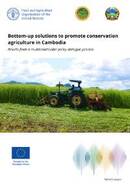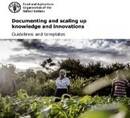Публикации
Results from a multistakeholder policy dialogue process
This policy brief presents the results of a multistakeholder policy dialogue process led by the Cambodia Conservation Agriculture and Sustainable Intensification Consortium (CASIC) with technical support from FAO's Office of Innovation (OIN) in the framework of the EU-funded TAP-AIS project. A series of policy dialogue events, organized from April through September 2022, brought together local and national stakeholders, including farmers and their organizations, private sector businesses, government officials, NGOs, development partners and more, to discuss key issues and potential solutions to promote the expansion of conservation agriculture in Cambodia. Conservation agriculture is an...
Assessing or understanding the Agricultural Innovation System (AIS) is an essential step to better understand the needs, new skills and functions needed by the actors and the system. To accelerate the uptake of innovation and progress towards eradicating poverty, there is an urgent need for well-coordinated, demand-driven and market-oriented information, knowledge, technologies and services.
This document includes a set of information, templates and resources that aim to assist Agricultural Innovation System actors, stakeholders, producers and farmers to develop and share impactful stories. It guides actors and organizations across all sectors in the innovation system to collect and document case studies, success...
The global impacts of the climate crisis are becoming ever clearer, and natural resources and ecosystems are being depleted. Despite some progress, hunger and poverty persist, and inequalities are deepening. The world is realizing that unsustainable high external inputs and resource-intensive industrialized systems pose a real danger of biodiversity loss, increased greenhouse gas emissions, shortages of healthy food, and the impoverishment of dispossessed peasants around the world. There is global consensus on the urgent need for a transition to agri-food systems that ensure food and nutrition security, social and economic equity, and sustain the ecosystem on which all these elements...
In the rapidly changing context of agri-food systems, extension and advisory services (EAS) are expected to provide new roles and services that go well beyond the traditional production-related technology transfer. Consequently, pluralistic EAS systems with diverse actors have emerged with diverse actors, including private and civil society organisations. These multiple EAS actors must adopt innovative entrepreneurship models if they are to act proactively and respond to the increasing diversity of farmers’ demands while staying independent and sustainable. Entrepreneurship in EAS means applying innovations such as creative and sustainable business models that can capture opportunities and new ideas, broaden the range...
This training manual, which is based on a methodology developed by FAO’s Research and Extension Unit (OINR), presents a training course on assessing AIS consisting of eight modules. After completing the training, trainees will achieve the following specific objectives: be familiar with the concept of agricultural innovation systems (AIS) and the Tropical Agriculture Platform’s (TAP) approach to capacity development on AIS; Be familiar with the FAO framework on assessment of AIS and the approaches and tools to use in each step, and; be able to plan and carry out an assessment of AIS and using results in policies and programmes....





